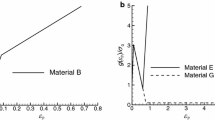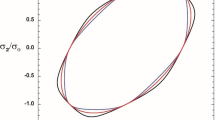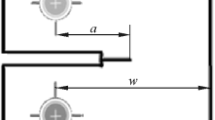Abstract
Plane stress mode I near-tip fields in orthotropic materials are examined. Plastic orthotropy is described by Hill's quadratic yield function and the strain hardening behavior is given by an appropriate generalization of a uniaxial tensile power-law stress-strain relation. Pronounced changes in the pattern of the angular variations of crack-tip fields have been observed with the degree of plastic orthotropy and the amount of strain hardening. Possible shapes and sizes of plastic zones (as inferred from effective stress contours) are presented for high- and low-hardening materials and a wide range of plastic orthotropy. The shape of the plastic zone for a particular case of plastic orthotropy agreed remarkably well with the zone of intense straining induced by an appropriately orientated crack within a graphite/epoxy laminate.
Résumé
On examine les champs de contraintes planes selon un mode I au voisinage de l'extrémité d'une fissure dans des matériaux orthotropes. L'orthotrope plastique est décrite par la fonction quadratique de plastification de Hill, et le comportement à l'écrouissage est donné par une généralisation adéquate d'une relation tensioncilatation de forme parabolique, sous traction mono-axiale. On a observé des modifications profondes dans l'aspect des variations angulaires des champs d'extrémité de fissure, selon le degré d'orthotropie plastique et infensité de l'écrouissage. Pour des matériaux très sujets ou peu sujets à l'écrouissage, et pour une large gamme d'orthotropies plastiques, on présente les formes et dimensions possibles des zones plastiques, telles qu'elles se deduisent des contours effectifs de contraintes. La forme de la zone plastique correspondant au cas particulier d'une orthotropie plastique s'accorde remarquablement bien à la zone de dilatation importante créée par une fissure d'orientation appropriée, dans une plaque de graphite-epoxy.
Similar content being viewed by others
References
R. Hill, Proceedings Royal Society London, Series A, 193 (1948) 281–291.
J.L. Bassani, International Journal of Mechanical Sciences 19 (1977) 651–660.
J.F.W. Bishop and R. Hill, Philosophical Magazine 7 (1951) 414–427.
R. Hill, Mathematical Proceedings Cambridge Philosophical Society 85 (1979) 179–191.
J.W. Hutchinson, Journal of the Mechanics and Physics of Solids 16 (1968) 13–31.
J.W. Hutchinson, Journal of the Mechanics and Physics of Solids 16 (1968) 337–347.
J.R. Rice and G.F. Rosengren, Journal of the Mechanics and Physics of Solids 16 (1968) 1–12.
C.F. Shih, “Elastic-Plastic Analysis of Combined Mode Crack Problems”, Ph.D. thesis, Harvard University (1973).
C.F. Shih, Fracture Analysis, ASTM STP 560, American Society for Testing and Materials (1974) 187–210.
K. Hayashi, Journal of the Mechanics and Physics of Solids 27 (1979) 163–174.
J. Pan and C.F. Shih, the Mechanics of Materials 5 (1986) 299–316.
J. Pan, Journal of the Mechanics and Physics of Solids (1986) 617–635.
J.R. Rice, Transactions of the ASME, Journal of Applied Mechanics 35 (1968) 379–386.
J.W. Hutchinson, Transactions of the ASME, Journal of Applied Mechanics 50 (1983) 1042–1051.
Y.T. Yeow, D.H. Morris and H.F. Brinson, Experimental Mechanics 19 (1979) 1–8.
C.F. Shih, “Tables of Hutchinson-Rice-Rosengren Singular Field Quantities”, MRL E-147, Material Research Laboratory, Brown University (1983).
J.R. Rice, in Mechanics of Solids: The R. Hill Anniversary Volume, H.G. Hopkins and M.J. Sewell (eds.), Pergamon Press, Oxford (1982) 539–562.
J. pan, “Plane-Stress Crack-Tip Stress Field for Perfectly Plastic Orthotropic Materials”, submitted for publication.
N. Levy, P.V. Marcal, W.J. Ostergren and J.R. Rice, International Journal of Fracture Mechanics 7 (1971) 143–156.
J.R. Rice and D.M. Tracey, in Numerical and Computer Methods in Structural Mechanics, S.J. Fenves et al., Academic Press, New York (1973).
D.M. Tracey, Transactions of the ASME, Journal of Engineering Materials and Technology 98 (1976) 146–151.
D.M. Parks, “Some Problems in Elastic-Plastic Finite Element Analysis of Cracks”, Ph.D. thesis, Brown University, Providence, RI (1975).
C.F. Shih, Journal of the Mechanics and Physics of Solids 29 (1981) 305–326.
J.R. Rice, Mechanics of materials 3 (1984) 55–80.
J.R. Rice and R. Nikolic, Journal of the Mechanics and Physics of Solids 33 (1985) 595–622.
J.R. Rice, “Tensile Crack Tip Fields in Elastic-Ideally Plastic Crystals”, Report No. Mech-106, Division of Applied Sciences, Harvard University (July 1987) to be published.
J.R. Rice, Journal of the Mechanics and Physics of Solids 21 (1973) 63–74.
Author information
Authors and Affiliations
Rights and permissions
About this article
Cite this article
Pan, J., Fong Shih, C. Plane-stress crack-tip fields for power-law hardening orthotropic materials. Int J Fract 37, 171–195 (1988). https://doi.org/10.1007/BF00045862
Received:
Accepted:
Issue Date:
DOI: https://doi.org/10.1007/BF00045862




